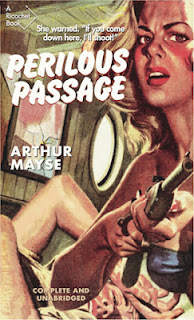This annus horribilis draws to a close – thank God – meaning the time has come to recap the last twelve months of reading old books. I tackled a bunch, twenty-one of which were reviewed here and in the pages of Canadian Notes & Queries. I'm counting Arthur Stringer's 1936 novel The Wife Traders and its British reworking, Tooloona, as two.
Fight me.
They're two different books... and having slogged my way through both, I've earned it.
Stringer proved to be this year's most read author, though I'm at a loss to explain why. I read four books by this son of Chatham, which is more than the previous seven years combined. The majority were pretty awful, but one made it onto my annual list of the three out-of-print reads most deserving a return to print:
Get it while you can, then share it with the children in your life.
Arthur Stringer
New York: Century, 1913
Better known under the later (superior) title Never-Fail Blake, this story of one man's relentless drive to bring another to justice was one of Stringer's most reprinted thrillers. Today, it is all but forgotten. It doesn't deserve that fate.
Garnett Weston
New York: Messner, 1944
This was the second Weston novel read this past summer. Where the first, The Legacy of Fear, disappointed, Poldrate Street entertained as the year's most unpleasant, stomach-turning read. Voyeurism, adultery, greed, murder, and something approaching necrophilia figure. No disappointment here!
Three of the books I reviewed this year are currently in print:
Dear Departed stands out as a relatively new book. The first true collection of Brian Moore short stories, it features writing that originally appeared between 1956 and 1961. Dear Departed was published just last year by Belfast's Turnpike Books, but went almost unnoticed in the author's adopted land. The only review I've seen or heard is Randy Boyagoda's on The Next Chapter.
Having been elevated in 2012, Grant Allen's An African Millionaire (1897) holds certain distinction as a Penguin Classic. Much as I like the novel, I wonder why. The Woman Who Did is a much better, more interesting, more enduring, and more culturally significant work.
Never mind.
Give An African Millionaire a read, but if you want Allen at his best I recommend The Woman Who Did, The Devil's Die, For Mamie's Sake, Michael's Crag, Under Sealed Orders, Hilda Wade, What's Bred in the Bone or The British Barbarians.
Brash Books is in the process of returning every Tom Ardies novel to print. The author's second, This Suitcase is Going to Explode (1972) has the defeated hero of the first, Charlie Sparrow, pick himself up to save us all. The third and final Sparrow novel is titled Pandemic (1973), in which he saves us from same.
At least, I think he does.
Praise this year goes again to Stark House (first recognized in 2012) for its continued dedication to the work of Douglas Sanderson (aka Martin Brett, aka Malcolm Douglas). This year, the publisher put one foot outside its usual crime territory in publishing Dark Passions Subdue, which I reviewed here ten years ago. Sanderson's debut novel, it concerns a male McGill student's attraction to another man.
Dark Passions Subdue was first published in 1952 by Dodd, Mead. The next year, Avon brought it out as a mass market paperback. The McGill University Library does not have a copy of either edition. Now's its chance.
I was involved in the reissue of only one novel this year. Due to production matters, it's been pushed into next. Here's something to look forward to in the New Year:
- I will focus more on francophone writers;
- I will review more non-fiction;
- I will keep kicking against the pricks.
Bonne année!
Related posts:
The Very Best Reads of a Plague Year (2020)
The Very Best Reads of a Very Strange Year (2019)
Best Books of 2018 (none of which are from 2018)
The Year's Best Books in Review - A.D. 2017
The Year's Best Books in Review - A.D. 2016
The Year's Best Books in Review - A.D. 2015
The Christmas Offering of Books - 1914 and 2014
A Last Minute Gift Slogan, "Give Books" (2013)
Grumbles About Gumble & Praise for Stark House (2012)
The Highest Compliments of the Season (2011)
A 75-Year-Old Virgin and Others I Acquired (2010)
Books are Best (2009)
Arthur Stringer Unshackled (then bowdlerized)
Little Willie, Willie Won't Go Home
A Shadow Moves Through a Showy Underworld
The Dead of a Dead End Street
Fumbling Towards Legacy
Shorter Moore
Starting on on Grant Allen: A Top Ten
Getting to Know The Woman Who Did
A Nineteenth Century What's Bred in the Bone
Grant Allen Tells Us Like It Is
Criminal Notes & Queries
Have Bomb – Will Travel
The Jacket, the Dressing Gown and the Closet










































